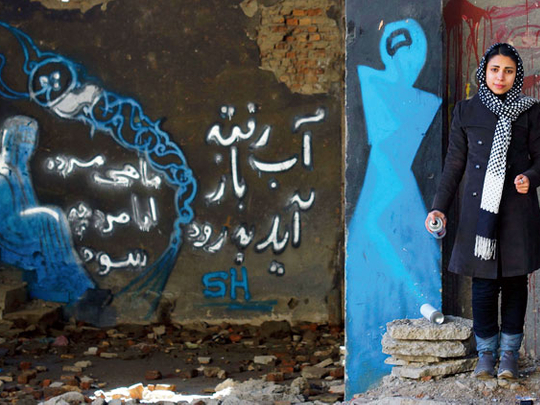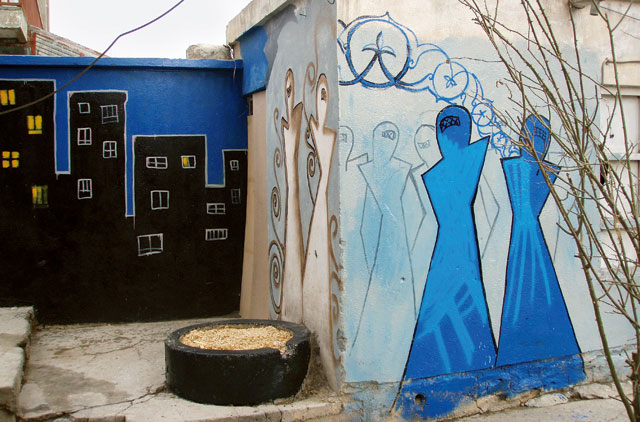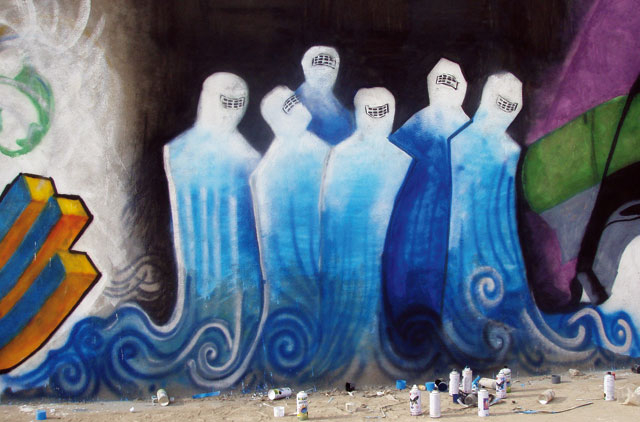
With a spray can in her hand and crouching in front of her mural, artist Shamsia Hassani gets to work. She's become world famous for her contemporary art - graffiti - and in her hometown of Kabul, Afghanistan, that's not easy.
But she's determined to highlight female oppression in her war-torn country through her work and make strangers take notice.
"I want to do something different, I want to express what us women have had to go through during these last few decades, and I believe my work sends a message of strength and unity,'' she says.
Shamsia, 24, was born in Iran in the late 1980s where her parents were refugees after fleeing Kandahar, Afghanistan. She was four years old when she took a paintbrush in her hand for the first time but during her school days her teachers told her art wasn't an option for Afghans.
"Like every child I liked drawing,'' she says. "But there was no teacher to encourage me when I was little. If anything, they tried to dissuade me. And when I couldn't study art in school I was devastated. I ended up doing accountancy instead.''
Finally able to spread her wings
Shamsia and her family moved to Kabul where she felt she could finally explore her passion for art. "I worked at the university day in, day out as an associate professor, teaching sculpture. I could finally open my wings. I was so happy," she says.
Since then she has found her skill lies with contemporary art. Her work has been shown in national galleries and overseas in Kashmir and Hamburg. But it was in 2010 when a British graffiti artist, who goes by the name Chu, came to Kabul University to hold a week- long course on street art, that Shamsia started graffiti.
"I learnt it was a lot easier to convey messages to people through graffiti compared to traditional art," she says. "If you have an exhibition, most uneducated people won't know about it. But if you have art like graffiti in the street, everyone can see that… If we can do graffiti all over the city, there will be nobody who doesn't know about art."
The hardships and terror in a city like Kabul at war, policed by uneasy security forces, discouraged most other students on Chu's course, but not Shamsia.
"I've learnt to use graffiti freely now," she says. "Hopefully it may bring about social changes in my society that has been steeped in war, isolation and discrimination. I want to help my people in any way and encourage them to look at a brighter future."
But it all comes with a risk. Shamsia knows she is in danger of being kidnapped or arrested if spotted by officials or worse still the Taliban.
"My country is still very traditional," Shamsia says. "As a woman I shouldn't be doing this. Some of my people will think I am a slave to western ideals and will be resentful of me. There's always a risk of being kidnapped or targeted by the Taliban who don't want to give way to women's liberation. But they aren't familiar with this work, they're not educated in art like I am. They don't know what it can do, and how it can mean so much to someone."
As a result, Shamsia, who is single and still lives with her parents, has to work in secret with the help of her male friend and fellow artist Qasam Foushanji.
"I try my best not to work outside because of the harsh violent reality on my doorstep. I take snapshots of ideas on my camera and then go home to work in private. Or I spend my time inside warehouses or around industrial parks, out of the sight of the general public so no one can report me or cause trouble," Shamsia admits. "But whenever I work or wherever I go there's the sound of gunshots and I'm constantly looking over my shoulder.
"Fortunately, I have never been shot at. However, there's always the danger of being hit by a sniper, that is very common. Sometimes, I feel really scared, depends on my state of mind on that day. Yet, no matter what fear nothing will prevent me from doing what I love doing."
These dangers Shamsia faces on a weekly basis make her more determined than ever to change the views of her fellow Afghans. That's why she travelled to Hamburg, Germany last year to take part in Wash festival, an international festival of graffiti.
"I hope my art will help Afghans understand the magic of art and bring a new shape to their hopeless lives," she says. "My work has changed my world in so many ways. As a woman I've come to understand things about Afghan women's miseries I never knew existed. The more I go out the more I realise what we can't and shouldn't do. Afghanistan has suffered so much in the last three decades, it's time to set things right, not a minute can be wasted."
Using art to make women feel stronger
Even before The Afghanistan War began in October 2001 the country faced struggles and its people have been ruled by a strict regime.
In February this year Afghan clerics proposed repressive new rules that state women are subordinate to men and should never mix. They should have a male guardian with them at all times when they travel. This makes Shamsia even more determined to make her work known. "Injustices are still being carried out against women especially in my country," she says. "I want my art to help women feel stronger. I want to compel them to see themselves as changers of their own destiny by opposing the elements that are bent on creating pain. I want us to live without fear."
Shamsia wants to be heard and be acknowledged. "The other reason I got into graffiti art was because women's rights are hardly ever talked about. We're just used to being coerced into doing things but now I believe my work and what I stand for is simply a triumph of women's submissiveness."
One of her murals shows a woman in a burka sitting on concrete steps with her head bowed. Shamsia explains the woman in her mural is wondering if she can get up or if she will fall.
Most of her work features women in burqas, but with hips and sharp shoulders. "Women of Afghanistan have had to carry the greatest of burdens on their shoulders, and have always needed to be careful," she says. "I want to remind the world of what we've had to live through. I am making sure the cultural heritage of Afghanistan stays alive for the world to see."




